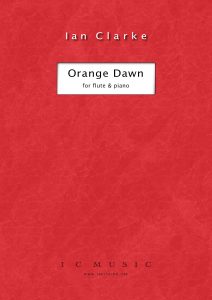Orange Dawn

Orange Dawn – (flute & piano) [advanced – requires open-holes]
Orange Dawn was originally inspired by the vision of a dawn scene in the Great Rift Valley of East Africa. Awakening exotic animal life was envisaged silhouetted against a dramatic rising sun. In the opening and closing sections alternative fingerings are used to help create a mysterious earthy quality to the sound; these are printed above the stave. The middle section the flute simultaneously plays graceful melody over fluid runs. Ideally suited to an open-hole flute due to one or note bends. The piano part is of moderate difficulty with a cadenza section. Originally composed in 1992 and critically acclaimed, Orange Dawn like many of Ian’s pieces is now performed internationally. It is listed on the AMEB (Australian Examinations Board).
Orange Dawn for flute and strings
Ian arranged Orange Dawn for flute and strings in 2022. The premiere performance was given by Jasmine Choi in New York with the New York Classical Players and Dongmin Kim conducting.
Some Email questions answered:
1) what inspired you to use the alternative fingerings?
I had recently co-written some tracks based on East Africa for use on Wildlife programmes using bamboo flute and concert flute (amongst other things) using some of the bright-tone and bamboo-tone fingerings from Robert Dick’s ‘Tone Development Through Extended Techniques’. Much of Robert’s work has been influential. This inspired me to explore writing my own flute & piano piece set in East Africa. Clearly exploring a more ethnic colour as I had done in the studio recordings was something I wished to build upon.
2) how long did it take to compose?
I can’t really remember. Perhaps over several months but not solid.
3) were there any specific things or events that inspired the writing of the whole piece?
See 1). We had been given a brief about the East African rift valley and encouraged to sound non-western. This led to the exploration of different colours. It is also interesting to note that having played a bamboo flute one is able to bring something of that sound to the flute more easily.
4) why are there 3 different editions of Orange Dawn?
For the first setting of the work in 1991 (or thereabouts) I borrowed a computer and some software. Initially I decided to put the fingerings on a separate chart. Later I reset the piece with the fingerings on the music itself. More recently I reset it again on a more advanced & professional programme (Finale) and took the opportunity to tweak a few things e.g. in the middle section the previous editions had runs in square brackets where some of the breaths are … I decided that it would sound better without them; pick up grace notes in the final section of the piano are now placed after the bar line so that they are more explicitly on the beat where I had originally intended them to be but through technical limitations hadn’t been able to put them.
5) is there a story behind the piece?
The above describes an inspirational scene rather than a programmatic story!